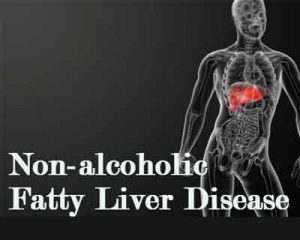- Home
- Editorial
- News
- Practice Guidelines
- Anesthesiology Guidelines
- Cancer Guidelines
- Cardiac Sciences Guidelines
- Critical Care Guidelines
- Dentistry Guidelines
- Dermatology Guidelines
- Diabetes and Endo Guidelines
- Diagnostics Guidelines
- ENT Guidelines
- Featured Practice Guidelines
- Gastroenterology Guidelines
- Geriatrics Guidelines
- Medicine Guidelines
- Nephrology Guidelines
- Neurosciences Guidelines
- Obs and Gynae Guidelines
- Ophthalmology Guidelines
- Orthopaedics Guidelines
- Paediatrics Guidelines
- Psychiatry Guidelines
- Pulmonology Guidelines
- Radiology Guidelines
- Surgery Guidelines
- Urology Guidelines
New pathways to treat non alcoholic fatty liver disease discovered

Researchers have discovered a new pathway in the liver that opens the door to treat non-alcoholic fatty liver disease, a condition that affects up to 25 percent of the population and may lead to cirrhosis and eventually liver cancer or failure, and lik...
Researchers from the University of South Carolina, Duke University, University of Alabama at Birmingham, and Metabolon Inc. Research Triangle Park have discovered a new pathway in the liver that opens the door to treat non-alcoholic fatty liver disease, a condition that affects up to 25 percent of the population and may lead to cirrhosis and eventually liver cancer or failure, and likely other liver diseases.
The study was published in Free Radical Biology & Medicine, one of the leading scientific journals in the field of oxidative stress and medicine.
The team found that a protein (TRPV4), which is a part of the body's defense system, is able to activate the release of a gas (nitric oxide). This gas then blocks one of the enzymes (CYP2E1) that is a major contributor to non-alcoholic liver disease and its progression. TRPV4 is already known to protect against cardiovascular abnormalities.
Now that this protein's capacity to block the development of non-alcoholic fatty liver disease has been discovered, the next step is to harness its preventive and treatment abilities. According to the authors, a new generation of TRPV4 agonists can now be tested to improve outcomes related to non-alcoholic fatty liver disease. The agonist is a chemical that will bind to this protein and activate the release of nitric oxide to block the harmful enzyme. Once the appropriate agonist is identified, it can be incorporated into medication for clinical treatment.
"There are currently no clinically proven drugs to treat non-alcoholic fatty liver disease," says Saurabh Chatterjee, an associate professor of environmental health sciences at the University of South Carolina's Arnold School of Public Health and the director of the Environmental Health and Disease Laboratory where the research was led. "Our goal is to find novel pathways in the liver that will result in a road to a cure, and this novel internal defense mechanism within the liver offers a very promising route."
In addition to revealing the benefits of activating TRPV4, the researchers also warn against the consequences of inhibiting the TRPV4 ion channel, an approach that can enhance hepatotoxicity (i.e., liver damage caused by chemicals), which can result from acetaminophen or alcohol over-consumption.
"This means that one has to be careful when aiming to inhibit TRPV4 for therapeutic purposes, such as when treating pain, inflammation or itching, or other conditions, in particular when inhibiting TRPV4 by systemic application of TRPV4-blockers," says Wolfgang Liedtke, a professor of neurology, anesthesiology and neurobiology at Duke University School of Medicine who first described TRPV4 16 years ago. "An attractive avenue to meet this therapeutic dilemma is to use herbal-derived TRPV4-activating compounds that might be more 'gentle' or targeted genetic manipulations of liver cells aiming to facilitate TRPV4-signaling in the liver when treating non-alcoholic fatty liver disease. These methods could also be a suitable approach to balance an eventually-needed systemic inhibition of TRPV4 that one aims for in order to treat pain, inflammation, fibrotic diseases or lung edema, in order to avoid additional damage to the liver."
This groundbreaking research has the potential to have a significant impact for both individuals and public health. "This type of research, which seeks novel pathways for treatment of diseases for which there are currently no therapeutic options is vitally important," notes collaborator and USC Vice President for Research Prakash Nagarkatti. "It opens doors that lead to the breakthroughs patients rely on to improve outcomes, enhance quality of life and even save lives."
Non-alcoholic fatty liver disease occurs when there is a buildup of extra fat in the liver (i.e., more that 5-10 percent of the liver's total weight) coupled with liver inflammation that is not caused by alcohol.
Affecting both children and adults, this disease tends to occur in individuals who are obese or overweight, have type II diabetes, high cholesterol and triglycerides. However, some people develop non-alcoholic fatty liver disease without any of these risk factors, possibly suggesting genetic risk factors. Healthy liver function is critical because the liver functions as a metabolic and chemical central laboratory in all vertebrate organisms including humans. For example, it processes food and drink into energy and nutrients, produces bile, blood coagulation factors and other blood proteins while processing and removing many harmful substances from blood.

Disclaimer: This site is primarily intended for healthcare professionals. Any content/information on this website does not replace the advice of medical and/or health professionals and should not be construed as medical/diagnostic advice/endorsement or prescription. Use of this site is subject to our terms of use, privacy policy, advertisement policy. © 2020 Minerva Medical Treatment Pvt Ltd